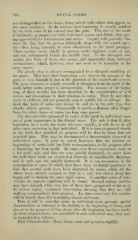Page 776 - My FlipBook
P. 776
786 DENTAL CARIES.
not distinguished on the charts, being mixed with others that appear on
the same surfaces.) In the incisors their beginning is usually marked
by the dark color of the enamel near the gum. This face of the tooth
is habitually gummed over with half-dried mucus and debris, thus giv-
ing opportnniti/ for fermentation and caries. Inquiry will generally dis-
close the fact that the person habitually sleeps with the mouth open,
this often being traceable to some obstruction in the nasal passages.
These cavities occur chiefly in persons under eighteen years of age,
and not uufrequently before the twelfth year. In the bicuspids and
molars this form of decay also occurs, and apparently from habitual
uncleanliness, which, however, does not seem to be traceable to the
same causes.
The fourth clas-s is always accompanied by a diseased condition of
the gums. They have their beginnings very close to the margin of the
gum, or even beneath it, just at the junction of the enamel and cement.
The gum, however, is usually everted or shrunken from the neck of the
tooth before caries proper is demonstrable. The manner of the begin-
ning of these cavities has been described in the consideration of acid
mucus and absorptions in their relations to caries. They do not often
occur in children, but are generally seen in middle life or old age. In-
deed, this form of caries may almost be said to be the only tyjie that
attacks elderly persons. Occasionally it wrecks a denture after danger
from the other classes of caries has long since passed.
The characterisfk'S presented by caries of the teeth in individual cases
are of great importance in the clinical sense. The rule is that if, after
beginning in a tooth, the caries advances rapidly, it will do so in all
other cases occurring in that individual. If it is seen to proceed slowly
in the teeth first attacked, its progress will be slow in those that are
attacked later. This may be denominated a characteristic observed in
individual cases. It must be noted, however, that the number of
beginnings of caries hold but little correspondence to the progress after
a beginning has been made. In some cases decay commences early in
a few teeth only, and they are very quickly destroyed ; in other cases
the individual teeth are attacked at intervals of considerable duration,
and in each case are quickly destroyed. It is not uncommon in the
examination of cases in ^\hich there have been no dental operations to
find that several teeth have been destroyed by caries, while all the
others have entirely escaped, or that in a very few others decay has
begun and is running the same rapid course. In another series of indi-
viduals an opposite condition will be found. Several carious cavities
may have formed, while very few of them have progressed so far as to
do serious injury, continued observation showing that they are still
making compai-atively slow progress. In other cases verv few cavities
will be found, these few remaining almost stationary.
Thus it will be seen that caries in individual cases presents special
characteristics in reference to the liability to the beginning of decay, and
also as to the progress of that decay after the beginning has been made.
As these characteristics are combined in each individual case, thev may
be fornndated as follows :
First Characteristic : Many decays start and progress rapidly.


